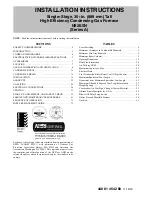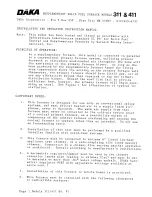
508187-01
Issue 2116
Page 27 of 51
Combustion Air Inducer (B6) and Cold End Header Box
All A80UH2E / 80G2UHE(L) units use a two-speed
combustion air inducer to move air through the burners
and heat exchanger during heating operation. The blower
uses a 120VAC motor. The motor operates during all
heating operation and is controlled by integrated control
control A92. The inducer also operates for 15 seconds
before burner ignition (pre-purge) and for 5 seconds after
the gas valve closes (post-purge). The inducer operates
on low speed during first-stage heat, then switches to high
speed for second stage heat.
The combustion air inducer is installed on the cold end
header box (CEHB). The cold end header box is a single
piece made of hard plastic. The box has an internal
channel where the combustion air inducer creates negative
pressure at unit start up. The channel contains an orifice
used to regulate flow created by the combustion air inducer.
The box has pressure taps for the combustion air inducer
pressure switch hoses. The pressure switch measures the
pressure differential across the cold end header box orifice
or difference in the channel and the box.
If replacement
is necessary the gaskets used to seal the box to the
vestibule panel and the combustion air inducer to the
box, must also be replaced.
A pressure switch measures the pressure differential across
the CEHB orifice to prove inducer operation. The CEHB
orifice will be different for each model. When the proving
switch opens, the furnace control (A92) immediately closes
the gas valve to prevent burner operation.
Combustion Air Inducer Pressure Switch (S18) (Figure
A80UH2E / 80G2UHE(L) series units are equipped with
a dual combustion air pressure switch (first and second
stage) located on the CEHB. The switch is connected
to the cold end header box by means of flexible silicone
hoses. It monitors negative differential pressure across the
cold end header box orifice.
The switches are a single-pole single-throw pressure
switches electrically connected to the integrated control.
The purpose of the switches is to prevent burner operation
if the combustion air inducer is not operating, the inlet or
exhaust pipes or heat exchanger are restricted.
On heat demand (first or second stage) the switch senses
that the combustion air inducer is operating. It closes a
circuit to the integrated control when pressure across the
CEHB orifice becomes greater then the switch set point.
Set points vary depending on unit size. See Table 9. Both
pressures sensed by the switches are negative relative to
atmospheric pressure. If the inlet or exhaust pipes, or the
heat exchanger become obstructed, the switch senses the
loss of differential pressure and opens the circuit to the
furnace integrated control and gas valve. A bleed port on
the switch allows relatively dry air in the vestibule to purge
switch tubing, to prevent condensate build up.
Figure 12. Combustion Air Inducer Pressure Switch
Tap
High Fire
Switch
Low Fire
Switch
Bracket
3/16” terminals
1/4“ terminals
NOTE:
The switch is factory set and is not field adjustable.
It is a safety shut-down control in the furnace and must
not be by-passed for any reason. If switch is closed or
bypassed, the control will not initiate ignition at start up.
Unit
Set Point
Low Heat
(in. w.c.)
Set Point
High Heat
(in. w.c.)
-045*12
0.30
0.68
-070*12
0.35
-090*12
0.30
-090*16
-110*16
-110*20
Table 9.
0 - 4,500 ft.
NOTE:











































